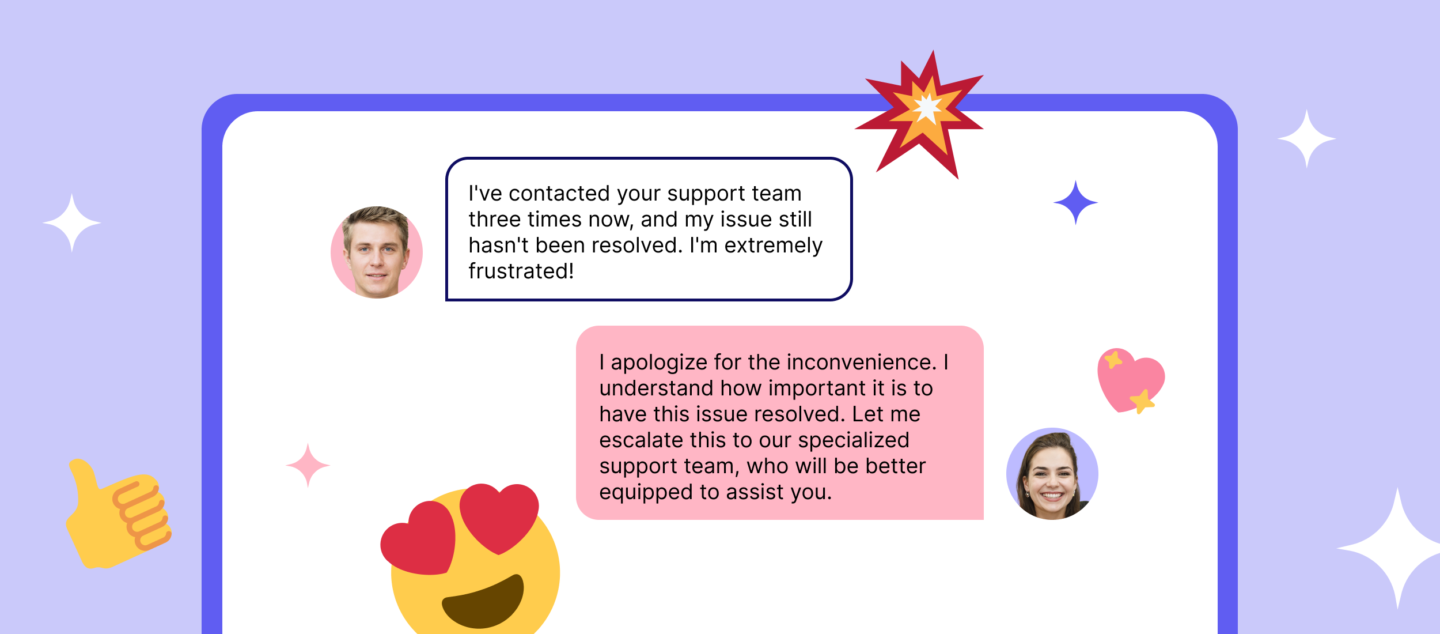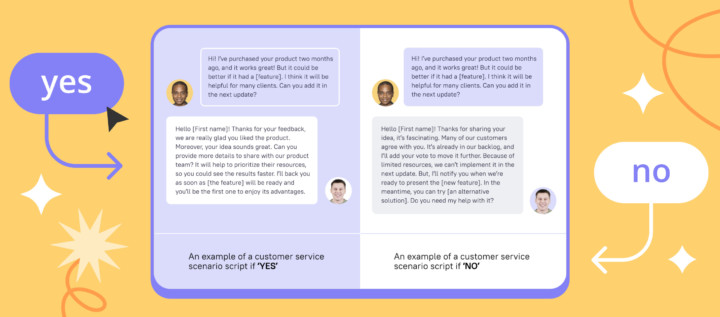5 scripts and best practices to handle customer escalation in 2023

In today’s competitive business landscape, delivering exceptional customer service is more important than ever. One critical aspect of customer service is handling customer escalation — when a customer’s concern requires the attention of higher-level support staff or management due to its complexity, severity, or the customer’s dissatisfaction with prior attempts at resolution.
This article will delve into the intricacies of customer escalation, its importance in fostering customer satisfaction, best scripts and practices for handling escalated situations.
Read also: 10 conversion rate optimization tools to enhance your funnel and boost revenue
Benefits of handling customer escalation cases
Customer escalation can occur for various reasons, including unresolved issues, prolonged wait times, inadequate communication, or dissatisfaction with the provided solutions.
Implementing a well-designed customer escalation process offers several benefits, including
- Properly managed escalation ensures that customers receive timely, appropriate, and satisfactory resolutions to their concerns, leading to increased satisfaction and loyalty.
- By demonstrating a commitment to resolving escalated customer issues, businesses can foster trust and brand reputation.
- Escalation channels enable customer service representatives to access higher-level resources, specialized knowledge, or additional authority. It facilitates quicker and more effective resolution of complex or challenging issues.
- Escalated issues can provide businesses with valuable insights into potential areas for improvement, allowing them to enhance their products, services, and overall customer experience.
- By effectively managing escalated issues, businesses can minimize the risk of customers sharing negative experiences through word of mouth or social media, thus protecting the company’s reputation.
- A streamlined escalation process can reduce the time and resources needed to resolve customer issues, leading to improved operational efficiency and cost savings.
Read also:
15 best lead generation services to grow your base in 2023
The 36 statistics on how chatbot for businesses grow your revenue in 2023
The secret weapon of your competitors or Why you should focus on customer service first
5 scripts for customer escalation situations
Here are some example scripts to help guide customer service representatives through various stages of customer escalation:
- Recognizing the need for escalation
Customer: “I’ve contacted your support team three times now, and my issue still hasn’t been resolved. I’m extremely frustrated!”
CSR: “I apologize for the inconvenience and frustration you’ve experienced. I understand how important it is to have this issue resolved. Let me escalate this to our specialized support team, who will be better equipped to assist you. Can you please provide me with your contact information and a brief summary of the issue you’re facing?”
- Initiating escalation
CSR: “Thank you for providing the necessary information. I’m escalating your issue to our specialized support team, who will contact you within [time frame]. They have more experience with this issue and should be able to help you more effectively. In the meantime, if you have any other questions or concerns, please feel free to contact me.”
Read also: Customer engagement strategy template to create omnichannel campaigns
- Communicating progress
CSR: “Hello [Customer’s Name], I wanted to provide you with an update on your escalated issue. Our specialized support team is currently working on it, and they expect to have a resolution for you within [time frame]. We appreciate your patience, and we’ll be sure to keep you informed on the progress.”
- Following up after resolution
CSR: “Hello [Customer’s Name], I’m reaching out to confirm that our specialized support team has resolved your issue. We apologize for any inconvenience you’ve experienced, and we hope that the solution provided meets your expectations. If you have any further questions or concerns, please don’t hesitate to contact us.”
- Seeking feedback after escalation
CSR: “Now that your issue has been resolved, we would appreciate any feedback you may have about your experience with our escalation process. Your input will help us improve our support services and deliver the best customer experience. You can share your feedback through [feedback channel], or feel free to contact me directly.”
By using these example scripts as a guideline, customer service representatives can effectively manage customer escalation, ensuring a smoother and more satisfying experience for customers.
Read also: 17 Zendesk alternative services and 13 live chat alternatives to try this year
Best practices to handle customer escalation cases
Implementing customer escalation best practices is vital to ensuring a smooth and effective process that leads to increased customer satisfaction. Here are some best practices to consider when handling customer escalation:
- Establish a well-defined escalation process that outlines the steps to be taken, the roles and responsibilities of each team member, and the timeframes for resolving escalated issues.
- Ensure that your customer service representatives are well-trained in identifying when an issue requires escalation and how to manage the process effectively. Empower them with the tools and authority needed to handle escalated situations confidently.
Personalize your customer communication with Dashly

- Clearly communicate the expected response and resolution times for escalated issues, both internally and to customers. This helps manage customer expectations and ensures that issues are addressed in a timely manner.
- Encourage your customer service team to empathize with customers and practice active listening. This allows them to understand the customer’s concerns and frustrations better and develop more effective solutions.
- Keep customers informed throughout the escalation process, providing updates on progress and expected resolution times. Transparent communication helps build trust and reassures customers that their concerns are being addressed.
- Implement a system for monitoring and tracking escalated issues to ensure they are resolved within the expected timeframes and to identify recurring issues requiring process improvements.
- Analyze and learn from escalated issues to identify areas for improvement in your products, services, or customer service processes. Use these insights to drive continuous improvement and enhance the overall customer experience.
- Once an escalated issue is resolved, follow up with the customer to ensure they are satisfied with the outcome and to gather feedback. This can help identify additional opportunities for improvement and demonstrates a commitment to customer satisfaction.
By adhering to these best practices, businesses can effectively manage customer escalation, leading to increased customer satisfaction, loyalty, and long-term success.
Read also:
👉 Live Chat Best Practices: 20 Hacks to Make Customer Service Better
👉7 Best Live Chat for eCommerce: Boost Conversion on your Website
👉 Top 5 live chat mobile app: find the best fit for your business
👉 Live Chat: How Online Chat Tool Can Help Your Business
👉 20 Best Live Chat Software for your website chat service




